by Winding Pathways | Sep 9, 2021 | Garden/Yard, Nature, Pests, Trees/Shrubs
We’ve got a peach problem.
Iowa’s frigid winters don’t favor peach trees, but we’ve got a tough one in the front yard that’s withstood temps down to 30 below zero. Each May it graces our yard with pink blossoms that transform into smallish, tasty peaches that ripen around Labor Day.
We love peaches. So do deer. That means that every fall we play a waiting game with them.
Peaches look ripe a few weeks before they truly soften and ripen. When they’re hard as stones they don’t taste good. We know it. So do the deer. This starts the tricky part.
When will they be ready to pick? If we don’t harvest them at just the right time the deer will do it for us. They’ll devour every single one the night before we intend to pick. This year we ran a wide circle of wire mesh around our tree, but we know hungry deer will figure out how to foil it.
-
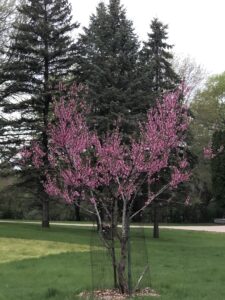
-
Each spring the fragrant pink blossoms grace our yard.
-
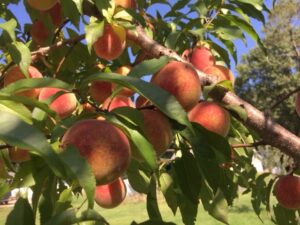
-
Deer sense when peaches are ready to eat.
As we write this on September 2nd our peaches are still hard. The deer are watching and waiting. We know because we found fresh scat just outside the wire fencing last night. We’ll let our readers know who gets the harvest.
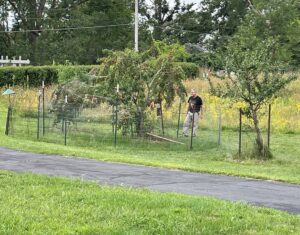
Adding extra fencing and stakes may keep the deer back.
by Winding Pathways | Sep 2, 2021 | (Sub)Urban Homesteading, Birds, Nature
A flurry of movement caught our attention. Just outside the dining room window, a tiny scrap of a bird flitted around. It wasn’t a wren, goldfinch, or sparrow. They’re around all year. Just what was it?
For most birders, May is the month to live for. Orioles, grosbeaks, tanagers, and warblers arrive as if by magic. They’re colorful, sing with gusto, and are easy to spot. It’s an exciting time, but it’s not THE ONLY exciting time.
All the colorful migrating May birds en route to northern nesting sites and the ones that stick around to nest locally are now heading south to avoid winter’s harshness. September is an outstanding birding month, but it’s also challenging.
September Birding
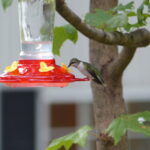
Birds stock up on high-calorie foods before their long migrations.
The birds are there but easy to miss. Many have gone through a late summer molt. They’ve replaced gaudy spring feathers with drab ones that enable them to hide better. September is a business month for birds. In May they happily court mates, but four months later the priority is beefing up their bodies for the long flight south. They dart about, often out of sight, seeking tasty insects, spiders, and seeds to fuel migration.
September birding takes patience. We find the most effective way to see birds is to sit quietly and watch. While we may slowly walk trails spotting birds in May, by September we sit on our deck in comfortable chairs, binoculars handy, and bird books and apps at the ready. We don’t find the birds. They find us, but because they don’t sing much and often look different than in Spring, identification is challenging.
Our backyard birding is exciting because we’ve diversified vegetation and have brushy areas, a prairie, a small pond, and big trees close by. However, we don’t just look there for birds. Sometimes we look upward to see soaring nighthawks, migrating raptors, and an occasional skein of Canada geese.
-
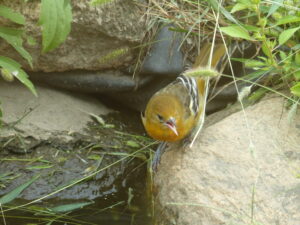
-
Birds stop for a drink and to fill up on the berries nearby.
-
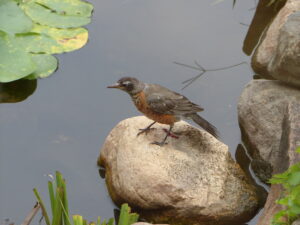
-
Keeping a wary eye, the robin cautiously gets a drink.
Identifying Fall Birds
To help with identification we use several printed bird books including the Peterson Guide and David Allen Sibley’s books. Increasingly we rely on Merlin. It’s an outstanding app produced by the Cornell University Laboratory of Ornithology. Even better, it’s free. The app easily helps identify species and shows many photos of every bird in spring/fall/juvenile/gender plumages. It also has range maps and recordings of the birds’ calls and songs. Merlin recently added a new function: sound identification. Point the phone at a singing bird and the app will help identify it by sound.
After we tentatively identify a bird, we try to confirm it by an Internet search and by consulting our birding friends. Our definitive online source is the Lab of Ornithology’s website. The site contains a vast amount of information, including how to access and use Merlin and eBird.
Easy to Keep Records
eBird allows us to record all bird species we spot in a day. Then we email results to the Lab for analysis. It’s great fun and helps the Lab research bird populations and movement.
There’s more to fall than football and leaf raking. It’s an excellent time to bird and the best birding is often the backyard.
by Winding Pathways | Aug 5, 2021 | (Sub)Urban Homesteading, Garden/Yard, Nature
When we moved to our home in 2010, we immediately began changing the landscaping. The former owner had mowed nearly our entire two acres. It was clipped, manicured, and lacking in diversity. The soil was sand, rock hard, or dense clay. From this sterile, unnatural yard we created a wondrous landscape rich in plant and animal life.
Over the years we removed exotic ornamental trees and replaced the mowed lawn with native prairie. Now, 11 years later, our yard has transformed into more natural landscapes filled with colorful and fascinating wildlife and plants.
In the early years, one thing puzzled us. No earthworms. If we wanted some for bait, we couldn’t find a single one. As the years moved forward, we began seeing a few worms, and then an abundance as they emerged after a light rain. What made the difference?
The Worm Dilemma
Worms are a dilemma for anyone wishing to favor native species. Common worm species are not native. Transported to the New World during early settlement days, they spread like crazy. Gardeners and farmers love worms for their diligent work softening, fertilizing, and aerating the soil. They are great for gardens but cause ecological damage in forests that evolved without them.
Mostly we like worms. They’re an indicator of soil fertility and health and make our gardens more productive. But, why didn’t we have many in the early years of our ownership?
We suspect the former owner did more than mow. He doused the land with artificial fertilizer and pesticides and suppressed plant diversity. Both made life difficult for worms and other creatures.
It took a few years of composting and diversifying plant species but gradually we saw encouraging signs. More and different beneficial insects came to find dinner and a home in our yard. Worms returned with gusto.
We don’t manage our yard to be completely organic. When we spot a poison ivy sprig our small squirt bottle of herbicide takes care of it. Neither of us wants the awful cases of rash the plant caused us in years past. But, that’s about it. We use no insecticides and, except for the poison ivy killer, no herbicide.
Asian Jumping Worms
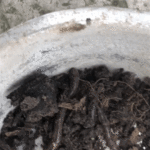
Asian Jumping Worms eat the leaf litter in forests that hold and break down into soil.
A few falls ago we brushed aside the garden mulch and were greeted by a few worms thrashing around at whirlwind speed. They were Asian jumping worms. New to Iowa they’ve been in many Eastern states for years. We easily identified them by their fast movement, white clitellum (the band around them), and their size. They’re just a bit smaller than a nightcrawler. These worms damage forests by eating the leaf layer that nurtures many native species and prevents erosion.
Our chickens dined on the Asian jumpers we tossed into their run, but we’re sure we’ll find more.
by Winding Pathways | Jul 22, 2021 | Nature, Wonderment
Winding Pathways borders 110-acre Faulkes Heritage Woods, a primeval woodland that changed dramatically in 40 minutes last August 10, 2020, when a derecho roared through Eastern Nebraska, all of Iowa and into Illinois.
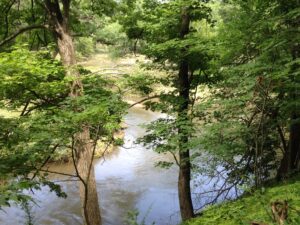
A short walk through the woods brought us to Indian Creek.
Prior to the storm, the view from our back deck was of towering oaks, hickories, walnuts, and a few maples. We’d often walk a quarter-mile to Indian Creek under a nearly closed crown of intertwined branches far overhead.
Then a derecho roared through with 140-mile-an-hour winds. (Watch several videos of the storm)
When we ventured outside, we found two big trees on our garage and cabin, and most of our own trees prostrated. Our power and Internet were down. Our biggest shock was the woods. Instead of immense giants, we saw trees that had withstood 150 years of wind shattered. Some were uprooted. Many snapped off with their trunks standing like poles. Others were twisted apart by the powerful wind.
It was devastating. Heartbreaking. All winter our view was of broken trees………until spring’s warmth worked magic on the woods.
-
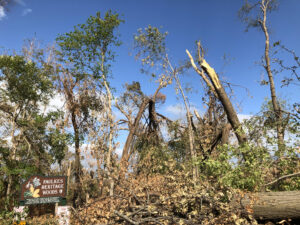
-
Faulkes Woods is still a tangle of jackstraw trees.
-
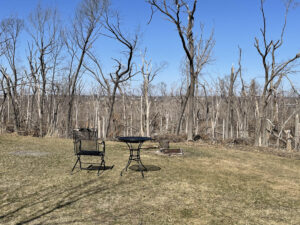
-
All winter we looked on broken trees.
-
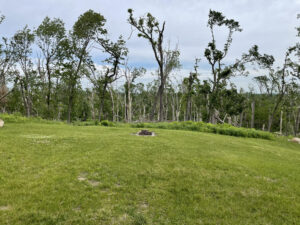
-
Springing Back from Derecho.
Forests are resilient. For the first April in over a century sunlight reached the forest floor. As it gained strength in May and June it triggered a resurgence of vegetation we’d never seen in the woods before. All were plants that can’t thrive in dense shade.
We were overjoyed to see tree sprouts. Baby oaks, hackberries, ironwood, maple, and basswoods popped up here and there. Soon they were joined by a thick growth of what many would call weeds. A few are new to us, including oakleaf goosefoot. Some are concerning. The sunshine is encouraging invasive garlic mustard, multiflora rose, and Japanese barberry, but we also spotted something delicious.
Long dormant raspberry and blackberry canes rose from the soil. We’ll enjoy a great berry harvest next summer and for many following years until new trees gradually shade them to dormancy.
-
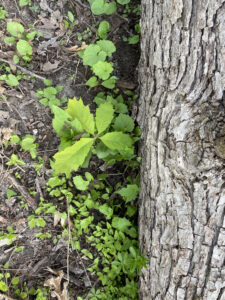
-
The seedling radiated hope.
-
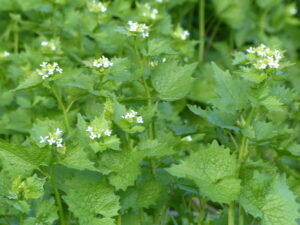
-
Invasive plants take advantage of change.
-
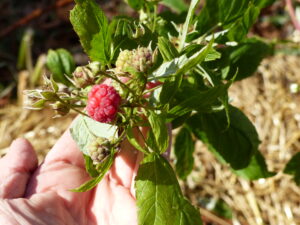
-
Miracle in the rubble
Nature is resilient, and we’re watching a woodland resurrection from our back deck.
-
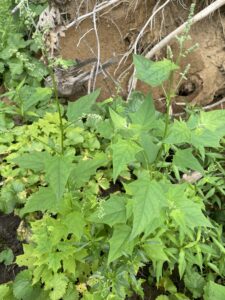
-
This sun lover is nestled close to the uprooted log.
-
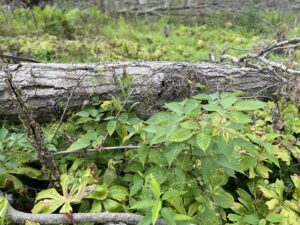
-
Sun loving brambles surround fallen log.
Watch a video from 12th Ave. Bridge in Cedar Rapids.
by Winding Pathways | Jul 15, 2021 | (Sub)Urban Homesteading, Foraging, Nature
We take a walk every day, sometimes through urban and industrial areas. Other days find us on prairie or woodland trails. Everywhere we’re spotting an abundance of summer fruit being devoured by birds, woodchucks, chipmunks, and even deer.
Last August 10 a terrible derecho roared through our area, felling about 70% of mature trees. It seemed tragic but a year later vegetation has responded with enthusiasm in former shady places now sunlit. These include berries. Brambles: Newly sunny woods are filled with first-year black raspberry and blackberry canes. Next year there’ll be an abundance of berries. These are delicious food for people and wildlife. We like them fresh.
Here are few other species of berries. Some are human edibles. Others leave for the birds.
Munching
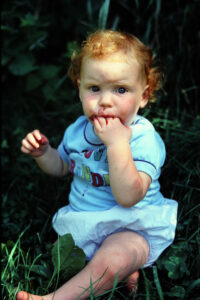
The sweet, but bland mulberries are children’s favorite.
Mulberries: These deliciously sweet, but bland, fruits have a long bearing season that’s mostly in June but lingers well into July. Robins just love them. So do many other birds……and children. Mulberries are a delicious underused human food. One of our favorite dishes is rhubarb mulberry pie.
Cherries: Many birds love domestic cherries. Our trees were almost ready to pick when a family of raccoons did the picking for us. No cherry pies this year. Wild black cherries are common. They’re edible to humans but are small, have a big pit, and are usually bitter. They’re hardly worth the effort to pick and process so we leave them for the birds to enjoy.
Leave These for the Wildlife
Chokecherries: They ripen in late June and into July. These pucker up any human trying to eat them, but birds love snacking on them.
Elderberries: These shrubs love trail and roadside sun and produce bunches of berries in late summer and into fall. Some people go to the trouble of making wine or jam from them but we leave them for the birds to enjoy.
Poison Ivy: Another berry to leave to the birds is poison ivy. This favorite of birds is how the plant spreads when the birds drop seeds. Leaves of three? Let them be!
-
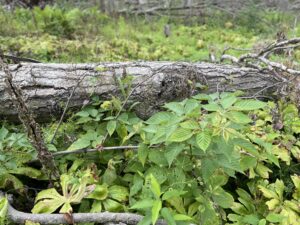
-
Berry canes emerge in the sun.
-
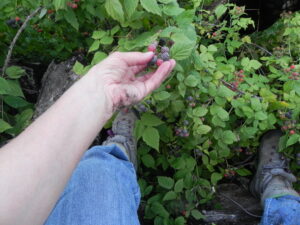
-
We bring along a small bag to bring home berries.
-
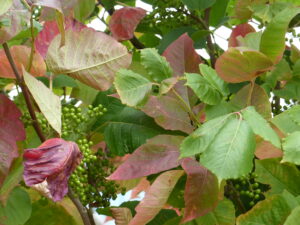
-
Birds spread poison ivy by eating the berries and pooping the seeds out later.
Dogwoods: These berries aren’t human food but make delicious bird chow. They ripen late and stay on the shrub through winter. Want to find bluebirds or robins on a cold January day? Find a patch of dogwoods that still have frozen berries clinging to them.
Winter Food
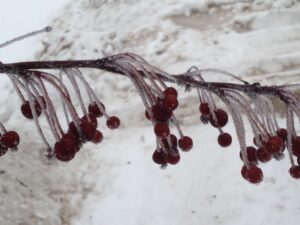
Waxwings flock to winter berries.
Highbush Cranberries: Look from late July on as they ripen in mid to late summer. A wildlife favorite, birds and chipmunks forage happily in the shrubs. Some berries linger into winter and often wintering waxwings greedily forage on the berries. Deer come by and munch both the leaves and berries.
When we set off on a summer walk, we stuff a bag or two into our pockets. Then, if we discover a blackberry patch, we’ve got a way to carry a few handfuls home.
by Winding Pathways | Jul 1, 2021 | Gazette Features, Hoover's Hatchery, Nature, Travel/Columns
For the past fifteen months Winding Pathways has been busy with writing features for the Cedar Rapids Gazette and blogs for Hoover’s Hatchery and FB Live monthly events. Catch up with our stories in The Cedar Rapids Gazette online.
Hoover’s Hatchery. Click on Flock Journey to read a variety of stories about all things chickens and other poultry. Or News From the Coop blogs.
Here is a list of the more recent features. Just click on the link and read away!
June 13, 2021. Alaska Recreation.
May 22, 2021. Museums of Quad Cities Area. https://www.thegazette.com/recreation/the-many-museums-of-the-quad-cities/
April 18, 2021. Finding Amelia. https://www.thegazette.com/recreation/an-unexpected-search-for-amelia-earhart/
April 11, 2021. Mississippi river Museum and Dubuque
March 25 , 2021 Cedar Falls_Waterloo. Memorable Museums
March 12, 2021. Time Travel. https://www.thegazette.com/subject/sports/outdoors/time-traveling-in-iowa-20210312
March 3, 2021 Entering the Battery Age (column)
February 19, 2021. Franconia Sculpture Park. https://www.thegazette.com/subject/sports/recreation/art-walk-in-a-park-20210219
February 2, 2021. Sprint Cars. https://www.thegazette.com/subject/sports/auto-racing/a-sprint-car-education-20210202
January 14, 2021. Embrace the Outdoors. https://www.thegazette.com/subject/sports/outdoors/embracing-x2014-and-enjoying-x2014-the-cold-outdoors-20210114
*****
December 20, 2020. Walking Cemeteries. https://www.thegazette.com/subject/sports/outdoors/a-peaceful-outdoor-walking-option-20201221
December 14, 2020 Iowa Meat Lockers: https://www.thegazette.com/subject/sports/outdoors/a-meaty-adventure-20201214
Nov 11, 2020 Iowa’s Inland Seas. https://www.thegazette.com/subject/sports/outdoors/enjoying-iowas-inland-seas-20201111
Oct 11, 2020. Barn Quilts. https://www.thegazette.com/article/barn-quilts-offer-brighten-up-the-countryside/
Sept 27, 2020: New Life to dead Trees. https://www.thegazette.com/subject/sports/outdoors/dead-trees-give-life-20200927
September 20, 2020: Walk Outside Safely. https://www.thegazette.com/subject/sports/outdoors/get-outside-and-walk-but-stay-safe-20200920
September 9, 2020: Rebirth Amid the Rubble https://www.thegazette.com/subject/sports/outdoors/a-rebirth-among-the-rubble-of-trees-20200906
August 22, 2020: Iowa’s National Parks. https://www.thegazette.com/subject/sports/outdoors/iowa-national-parks-guide-effigy-hoover-20200822
July 27, 2020: County Parks. https://www.thegazette.com/subject/sports/outdoors/take-advantage-of-iowas-county-gems-20200727
July 11, 2020: Tenting. https://www.thegazette.com/subject/sports/outdoors/why-rv-live-isnt-for-these-senior-tent-campers-20200711
June 26, 2020: Bear Sightings in Iowa: https://www.thegazette.com/subject/sports/outdoors/why-rv-live-isnt-for-these-senior-tent-campers-20200711
April 12, 2020” Walk on Wilder side. https://www.thegazette.com/subject/sports/recreation/take-a-walk-on-the-wilder-side-20200412





















